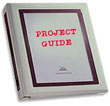Nine Secrets to a Successful Project
You will emerge smiling from a project that involves an outside supplier if you start early, modularize the work, schedule carefully and completely, establish and maintain a collaborative relationship, use a project guide to set and maintain a clear direction, track deliveries, respond to drafts and queries quickly, communicate frequently, and choose the best supplier.


If the project begins in crisis, it is likely to be a struggle all the way through. Contact us as soon as you think you may need help. (We’re more than willing to discuss a possible project, and with early notice we can give it the advance planning it deserves.)
Experience has taught us that everything will take twice as long at the start of a project as at the end. We will be establishing a working relationship; every task will be new; everyone will have suggestions to make; and mistakes will be made. Allow for this start-up time when you're scheduling the project.

Divide the work into the smallest practical parts so that you can establish
frequent checkpoints. By keeping the parts small, you’ll be able to correct
deviations from the intended course sooner rather than later. The small
error discovered sooner is always easier to correct than the big error
discovered later.

Forgive us for stating something so obvious, but this essential is often
overlooked. A list of final deadlines is not a schedule. A schedule shows
the flow of work for every component of the project, from start to finish.
It should show who will be doing what when, and it should allow for vacations
and holidays that will interrupt the work.

Establish a collaborative relationship. We’re going to be in this together.
Don’t think of us as outsiders, as “them,” but as part of the team. Keep
us informed. Our “need to know” is usually identical to that of anyone
working on the project in-house. We need to know when key people will be
away on vacation, when personnel changes are made, when a schedule changes.
Appoint one person in-house to act as our proxy: this person will make
sure that we do know what we need to know.

Have us establish a project guide and keep it up to date throughout the project, or, establish and maintain the guide yourself. It should have two sections: Style and Procedures.
Begin the style section with a set of specifications for the end products that you expect from us. Together, we will expand and refine the style section over the course of the project as decisions are made on style issues.
Begin the procedures section by describing the tasks that you expect us to perform while the project is underway. Write similar descriptions for the in-house personnel. This section will ensure that everyone on the project will know where to turn for answers to questions, and that replacing personnel in the middle of the project will not disturb the flow of work.
Either assign us the task of keeping the guide up to date, or assign
it to one person in-house.

Designate one person to receive all deliverables from us, send all shipments
to us, and assume responsibility for tracking. At Kraft & Kraft, we
call this person “the tracker.” We can supply forms for the tracker to
use.

Provide rapid feedback. Remember that all of us have a responsibility
to the schedule. Prompt feedback keeps a project on course and on time.
Respect our need for it. Be sure that you’ve assigned enough people and
time to the project to enable you to respond to work as it comes in.

Assign one person to handle all communication with us, and make sure that he or she either has ultimate responsibility for the project or has direct access to the person who does.
Don’t let a week go by without a conversation between us. Follow up with an exchange of written progress reports.
Important communications within the project team (which includes us,
remember) should always be in writing. The phone is handy, but phone calls
are ephemeral and subject to the distortions of memory. The written word
imposes precision on one’s thinking and provides a record. It’s a good
idea never to establish a specification, set a deadline, or call for a
change in a telephone conversation alone. Write a memo first. Fax it to
us or e-mail it to us. Follow up with a phone call if you have to discuss
or clarify something.


Choose a firm that will give the project close personal attention, a
supplier who cares about the project. At Kraft & Kraft, Eric Kraft
is always the final editor for every project, large or small. Every project
we have done is listed in our résumé. We’re proud of what
we’ve accomplished. If we undertake a project for you, we will expect to
be proud of it when we have finished it. For larger projects, we draw on
a group of skilled and experienced freelance professionals with whom we
have worked successfully in the past.

Eric Kraft, Project Director
Madeline Kraft, Business Director
Copyright © 1996 by Eric Kraft
WEB
CONTENT PRODUCTION
VIDEO
PRODUCTION
INTERACTIVE
INSTRUCTION
TEXTBOOKS
GENERAL
BOOKS